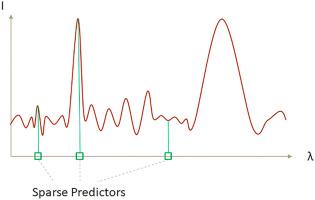当前位置:
X-MOL 学术
›
Anal. Chim. Acta
›
论文详情
Our official English website, www.x-mol.net, welcomes your
feedback! (Note: you will need to create a separate account there.)
Novel Mixed Integer Optimization Sparse Regression Approach in Chemometrics
Analytica Chimica Acta ( IF 5.7 ) Pub Date : 2020-11-01 , DOI: 10.1016/j.aca.2020.08.054 D. Bertsimas , D. Lahlou Kitane , N. Azami , F.R. Doucet
Analytica Chimica Acta ( IF 5.7 ) Pub Date : 2020-11-01 , DOI: 10.1016/j.aca.2020.08.054 D. Bertsimas , D. Lahlou Kitane , N. Azami , F.R. Doucet

|
Sparse mathematical modelling plays an increasingly important role in chemometrics due to its interpretability and prediction power. While many sparse techniques used in chemometrics rely on L1 penalization to create sparser models, Mixed Integer Optimization (MIO) achieves sparsity by imposing constraints directly in the model. In this paper, we develop an intuitive and flexible robust sparse regression framework using MIO. We use constraints and penalization to achieve sparsity and robustness respectively. We test and compare results with those obtained using other techniques generating sparser models such as LASSO and sparse PLS. We also use PLS as a baseline to compare predictive performance. We use a LIBS data set of certified reference materials (CRM) of various mineral ores to illustrate the framework using different objective functions. The MIO framework proposed improves accuracy, sparsity and robustness vs. LASSO and SPLS. MIO achieves an average R2 higher than other methods on average by at least 10.6%. Robust MIO approach also improves interpretability. It also uses 4.3 variables on average while LASSO and SPLS use 16.1 and 805.8 respectively. We also illustrate how interpretability can help build better models through examples derived from the data sets used. When adding noise to the signal, MIO achieves an R2 of 0.69 on average when all models have negative R2 values. The MIO framework proposed is versatile and could be used in other chemometrics applications.
中文翻译:

化学计量学中新的混合整数优化稀疏回归方法
由于其可解释性和预测能力,稀疏数学建模在化学计量学中发挥着越来越重要的作用。虽然化学计量学中使用的许多稀疏技术依赖 L1 惩罚来创建稀疏模型,但混合整数优化 (MIO) 通过直接在模型中施加约束来实现稀疏性。在本文中,我们使用 MIO 开发了一个直观且灵活的鲁棒稀疏回归框架。我们分别使用约束和惩罚来实现稀疏性和鲁棒性。我们测试结果并将其与使用其他生成稀疏模型(如 LASSO 和稀疏 PLS)的技术获得的结果进行比较。我们还使用 PLS 作为基线来比较预测性能。我们使用各种矿石的认证参考材料 (CRM) 的 LIBS 数据集来说明使用不同目标函数的框架。与 LASSO 和 SPLS 相比,提出的 MIO 框架提高了准确性、稀疏性和鲁棒性。MIO 的平均 R2 比其他方法平均高出至少 10.6%。稳健的 MIO 方法还提高了可解释性。它还平均使用 4.3 个变量,而 LASSO 和 SPLS 分别使用 16.1 和 805.8。我们还通过从所使用的数据集派生的示例来说明可解释性如何帮助构建更好的模型。在向信号添加噪声时,当所有型号的 R2 值为负时,MIO 的平均 R2 为 0.69。提出的 MIO 框架是通用的,可用于其他化学计量学应用。稳健的 MIO 方法还提高了可解释性。它还平均使用 4.3 个变量,而 LASSO 和 SPLS 分别使用 16.1 和 805.8。我们还通过从所使用的数据集派生的示例来说明可解释性如何帮助构建更好的模型。在向信号中添加噪声时,当所有型号的 R2 值为负时,MIO 的平均 R2 为 0.69。提出的 MIO 框架是通用的,可用于其他化学计量学应用。稳健的 MIO 方法还提高了可解释性。它还平均使用 4.3 个变量,而 LASSO 和 SPLS 分别使用 16.1 和 805.8。我们还通过从所用数据集派生的示例来说明可解释性如何帮助构建更好的模型。在向信号中添加噪声时,当所有型号的 R2 值为负时,MIO 的平均 R2 为 0.69。提出的 MIO 框架是通用的,可用于其他化学计量学应用。
更新日期:2020-11-01
中文翻译:

化学计量学中新的混合整数优化稀疏回归方法
由于其可解释性和预测能力,稀疏数学建模在化学计量学中发挥着越来越重要的作用。虽然化学计量学中使用的许多稀疏技术依赖 L1 惩罚来创建稀疏模型,但混合整数优化 (MIO) 通过直接在模型中施加约束来实现稀疏性。在本文中,我们使用 MIO 开发了一个直观且灵活的鲁棒稀疏回归框架。我们分别使用约束和惩罚来实现稀疏性和鲁棒性。我们测试结果并将其与使用其他生成稀疏模型(如 LASSO 和稀疏 PLS)的技术获得的结果进行比较。我们还使用 PLS 作为基线来比较预测性能。我们使用各种矿石的认证参考材料 (CRM) 的 LIBS 数据集来说明使用不同目标函数的框架。与 LASSO 和 SPLS 相比,提出的 MIO 框架提高了准确性、稀疏性和鲁棒性。MIO 的平均 R2 比其他方法平均高出至少 10.6%。稳健的 MIO 方法还提高了可解释性。它还平均使用 4.3 个变量,而 LASSO 和 SPLS 分别使用 16.1 和 805.8。我们还通过从所使用的数据集派生的示例来说明可解释性如何帮助构建更好的模型。在向信号添加噪声时,当所有型号的 R2 值为负时,MIO 的平均 R2 为 0.69。提出的 MIO 框架是通用的,可用于其他化学计量学应用。稳健的 MIO 方法还提高了可解释性。它还平均使用 4.3 个变量,而 LASSO 和 SPLS 分别使用 16.1 和 805.8。我们还通过从所使用的数据集派生的示例来说明可解释性如何帮助构建更好的模型。在向信号中添加噪声时,当所有型号的 R2 值为负时,MIO 的平均 R2 为 0.69。提出的 MIO 框架是通用的,可用于其他化学计量学应用。稳健的 MIO 方法还提高了可解释性。它还平均使用 4.3 个变量,而 LASSO 和 SPLS 分别使用 16.1 和 805.8。我们还通过从所用数据集派生的示例来说明可解释性如何帮助构建更好的模型。在向信号中添加噪声时,当所有型号的 R2 值为负时,MIO 的平均 R2 为 0.69。提出的 MIO 框架是通用的,可用于其他化学计量学应用。











































 京公网安备 11010802027423号
京公网安备 11010802027423号